Pantograph–Catenary Interaction Prediction Model Based on SCSA-RBF Network
Abstract
:1. Introduction
2. Pantograph–Catenary Finite Element Model [7]
3. Pantograph–Catenary Interaction Prediction Model
3.1. Model Architecture
3.2. Consideration of a Piecewise Linear Panhead Spring
3.3. Performance Evaluation of Prediction Model
4. Application in Optimization of Pantograph Parameters
5. Conclusions
Author Contributions
Funding
Institutional Review Board Statement
Informed Consent Statement
Data Availability Statement
Conflicts of Interest
References
- Luo, W. Tech Upgrades Power Trains to 453 km/h during Tests. People’s Daily (Edition 2). 2 July 2023. Available online: http://paper.people.com.cn/rmrb/html/2023-07/02/nbs.D110000renmrb_02.htm (accessed on 3 July 2023).
- Poetsch, G.; Evans, J.; Meisinger, R.; Kortüm, W.; Baldauf, W.; Veitl, A.; Wallaschek, J. Pantograph/catenary dynamics and control. Veh. Syst. Dyn. 1997, 28, 159–195. [Google Scholar] [CrossRef]
- Bruni, S.; Ambrosio, J.; Carnicero, A.; Cho, Y.H.; Finner, L.; Ikeda, M.; Kwon, S.Y.; Massat, J.-P.; Stichel, S.; Tur, M.; et al. The results of the pantograph–catenary interaction benchmark. Veh. Syst. Dyn. 2015, 53, 412–435. [Google Scholar] [CrossRef]
- Bruni, S.; Bucca, G.; Carnevale, M.; Collina, A.; Facchinetti, A. Pantograph–catenary interaction: Recent achievements and future research challenges. Int. J. Rail. Transp. 2017, 6, 57–82. [Google Scholar] [CrossRef]
- Song, Y.; Antunes, P.; Pombo, J.; Liu, Z. A methodology to study high-speed pantograph-catenary interaction with realistic contact wire irregularities. Mech. Mach. Theory 2020, 152, 103940. [Google Scholar] [CrossRef]
- Cho, Y.H. Numerical simulation of the dynamic responses of railway overhead contact lines to a moving pantograph, considering a nonlinear dropper. J. Sound Vib. 2008, 315, 433–454. [Google Scholar] [CrossRef]
- Wu, M.; Xu, X.; Yan, Y.; Luo, Y.; Huang, S.; Wang, J. Multi-parameter joint optimization for double-strip high-speed pantographs to improve pantograph-catenary interaction quality. Acta Mech. Sin. 2022, 38, 521344. [Google Scholar] [CrossRef]
- Jimenez-Octavio, J.R.; Carnicero, A.; Sanchez-Rebollo, C.; Such, M. A moving mesh method to deal with cable structures subjected to moving loads and its application to the catenary–pantograph dynamic interaction. J. Sound Vib. 2015, 349, 216–229. [Google Scholar] [CrossRef]
- Gregoria, S.; Tur, M.; Nadala, E.; Aguado, J.V.; Fuenmayor, F.J.; Chinesta, F. Fast simulation of the pantograph-catenary dynamic interaction. Finite Elem. Anal. Des. 2017, 129, 1–13. [Google Scholar] [CrossRef]
- Gregori, S.; Tur, M.; Pedrosa, A.; Tarancón, J.E.; Fuenmayor, F.J. A modal coordinate catenary model for the real-time simulation of the pantograph-catenary dynamic interaction. Finite Elem. Anal. Des. 2019, 162, 1–12. [Google Scholar] [CrossRef]
- Wu, T.X.; Brennan, M.J. Basic Analytical Study of Pantograph-catenary System Dynamics. Veh. Syst. Dyn. 1998, 30, 443–456. [Google Scholar] [CrossRef]
- Lopez-Garcia, O.; Carnicero, A.; Marono, J.L. Influence of stiffness and contact modelling on catenary-pantograph system dynamics. J. Sound Vib. 2007, 299, 806–821. [Google Scholar] [CrossRef]
- Duan, H.Y.; Dixon, R.; Stewart, E. A disturbance observer based lumped-mass catenary model for active pantograph design and validation. Veh. Syst. Dyn. 2022, 61, 1565–1582. [Google Scholar] [CrossRef]
- Wu, T.X.; Brennan, M.J. Dynamic stiffness of a railway overhead wire system and its effect on pantograph–catenary system dynamics. J. Sound Vib. 1999, 219, 483–502. [Google Scholar] [CrossRef]
- Gil, J.; Gregori, S.; Tur, M.; Fuenmayor, F.J. Analytical model of the pantograph-catenary dynamic interaction and comparison with numerical simulations. Veh. Syst. Dyn. 2022, 60, 132–155. [Google Scholar] [CrossRef]
- Gil, J.; Tur, M.; Correcher, A.; Gregori, S.; Pedrosa, A.; Fuenmayor, F.J. Hardware-in-the-loop pantograph tests using analytical catenary models. Veh. Syst. Dyn. 2022, 60, 3504–3518. [Google Scholar] [CrossRef]
- Lee, J.-H.; Kim, Y.-G.; Paik, J.-S.; Park, T.-W. Performance evaluation and design optimization using differential evolutionary algorithm of the pantograph for the high-speed train. J. Mech. Sci. Technol. 2012, 26, 3253–3260. [Google Scholar] [CrossRef]
- Su, K.X.; Zhang, J.W.; Zhang, J.W.; Yan, T.; Mei, G. Optimisation of current collection quality of high-speed pantograph-catenary system using the combination of artificial neural network and genetic algorithm. Veh. Syst. Dyn. 2022, 61, 260–285. [Google Scholar] [CrossRef]
- Huang, G.Z.; Wu, G.N.; Yang, Z.F.; Chen, X.; Wei, W. Development of surrogate models for evaluating energy transfer quality of high-speed railway pantograph-catenary system using physics-based model and machine learning. Appl. Energy 2023, 333, 120608. [Google Scholar] [CrossRef]
- Song, Y.; Wang, H.R.; Frøseth, G.; Nåvik, P.; Liu, Z.; Rønnquist, A. Surrogate modelling of railway pantograph-catenary interaction using deep Long-Short-Term-Memory neural networks. Mech. Mach. Theory 2023, 187, 105386. [Google Scholar] [CrossRef]
- Zhou, R.; Xu, X.H. Dynamic parameter optimization of high-speed pantograph base on swarm intelligence and machine learning. Int. J. Appl. Mech. 2023, 15, 2350078. [Google Scholar] [CrossRef]
- Wu, M.Z.; Liu, Y.; Xu, X.H. Sensitivity analysis and optimization parameters of high speed pantograph-catenary system. Chin. J. Theor. Appl. Mech. 2021, 53, 75–83. [Google Scholar] [CrossRef]
- EN50318:2018; Railway Applications-Current Collection Systems-Validation of Simulation of the Dynamic Interaction between Pantograph and Overhead Contact Line. European Committee for Electrotechnical Standardization: Brussels, Belgium, 2018.
- Mckay, M.D.; Conover, R.J.B.J. A comparison of three methods for selecting values of input variables in the analysis of output from a computer code. Technometrics 1979, 21, 239–245. [Google Scholar]
- Broomhead, D.S.; Lowe, D. Radial Basis Functions, Multi-Variable Functional Interpolation and Adaptive Networks; Royal Signals and Radar Establishment: Malvern, UK, 1988. [Google Scholar]
- Jebari, K.; Madiafi, M. Selection Methods for Genetic Algorithms. Int. J. Emerg. 2013, 3, 333–344. [Google Scholar]
- Askarzadeh, A. A novel metaheuristic method for solving constrained engineering optimization problems: Crow search algorithm. Comput. Struct. 2016, 169, 1–12. [Google Scholar] [CrossRef]
- EN50367:2020; Railway Applications-Current Collection Systems-Technical Criteria for the Interaction between Pantograph and Overhead Line. European Committee for Electrotechnical Standardization: Brussels, Belgium, 2020.
- EN50317:2012; Railway Applications-Current Collection Systems-Requirements for and Validation of Measurements of the Dynamic Interaction between Pantograph and Overhead Contact Line. European Committee for Electrotechnical Standardization: Brussels, Belgium, 2012.
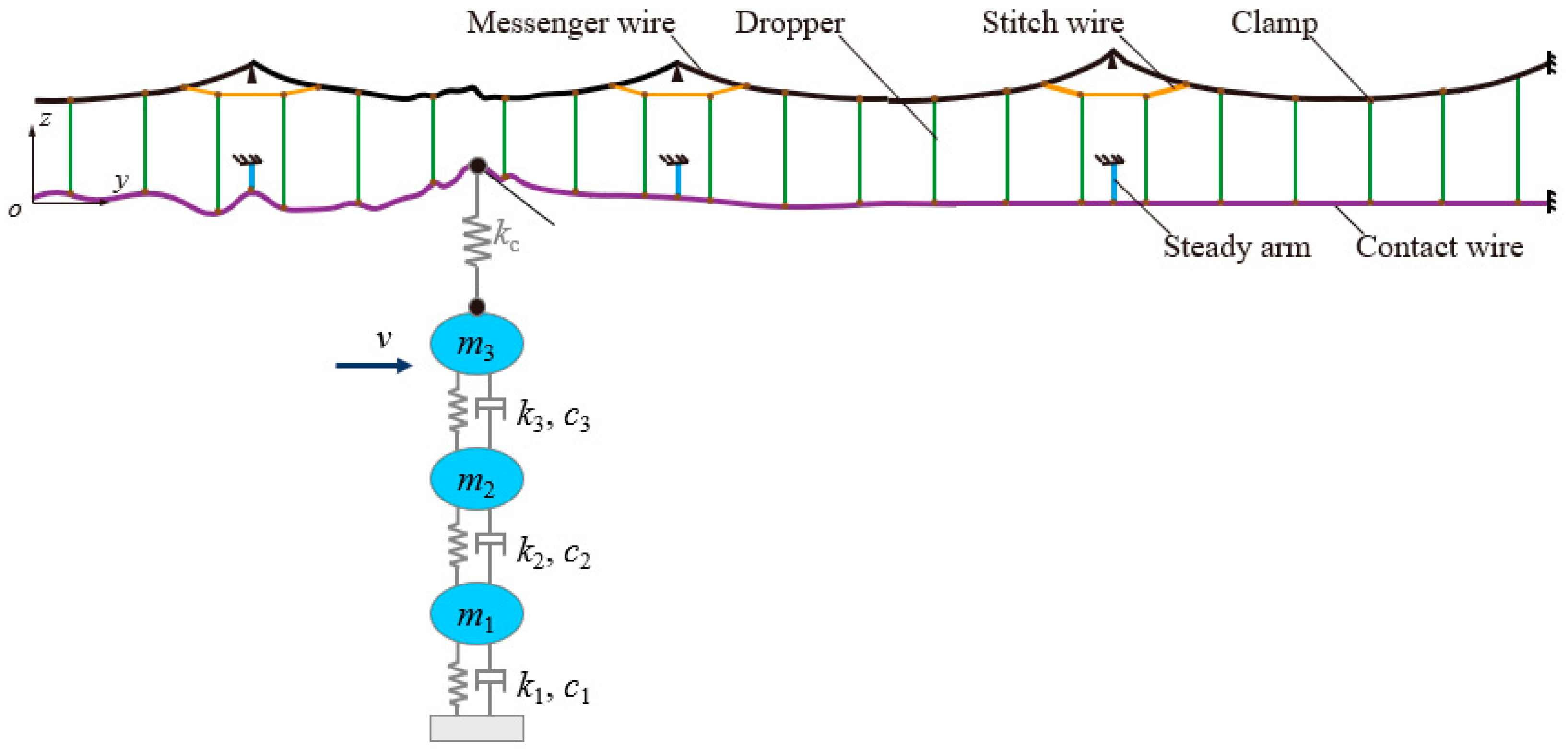
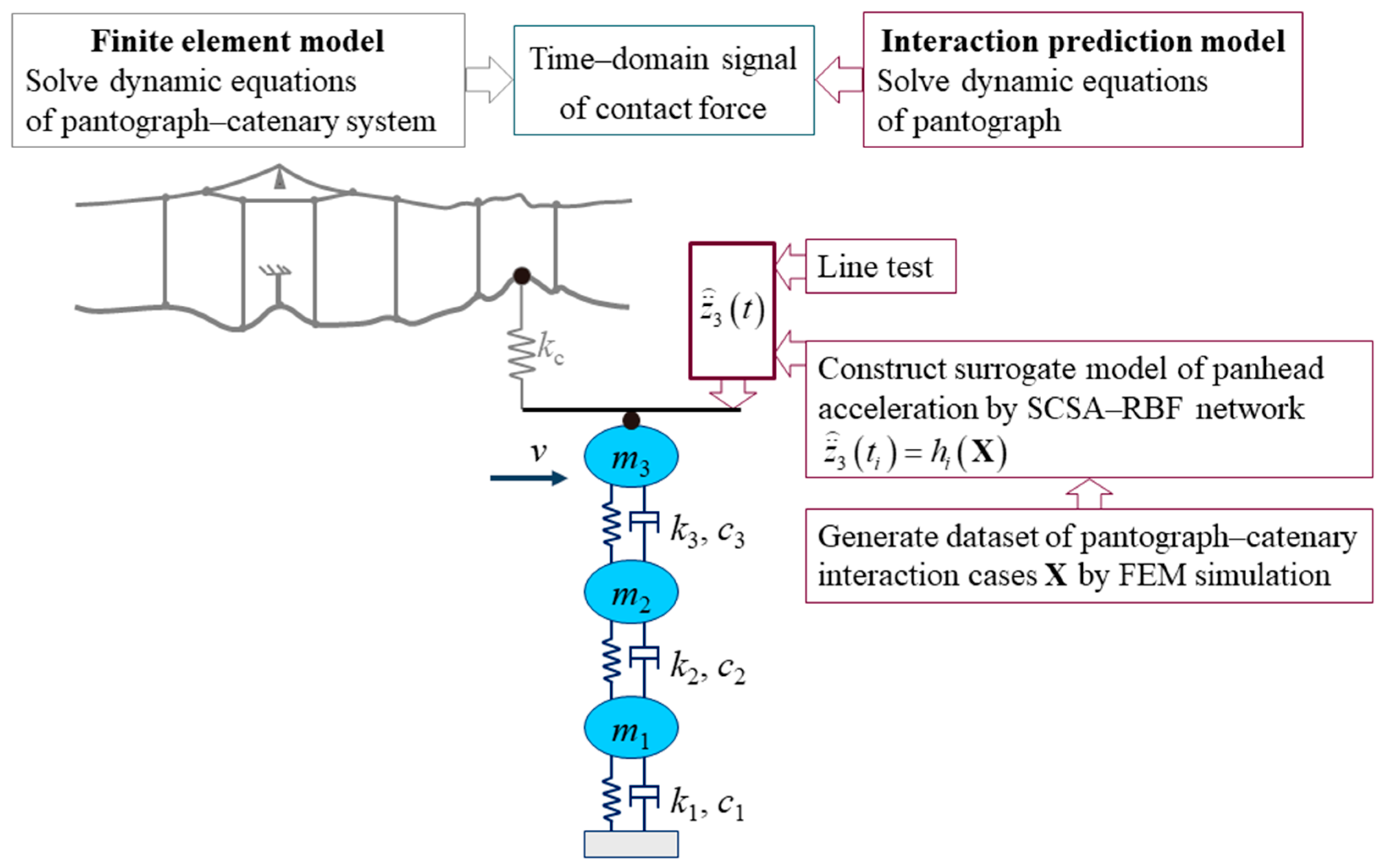
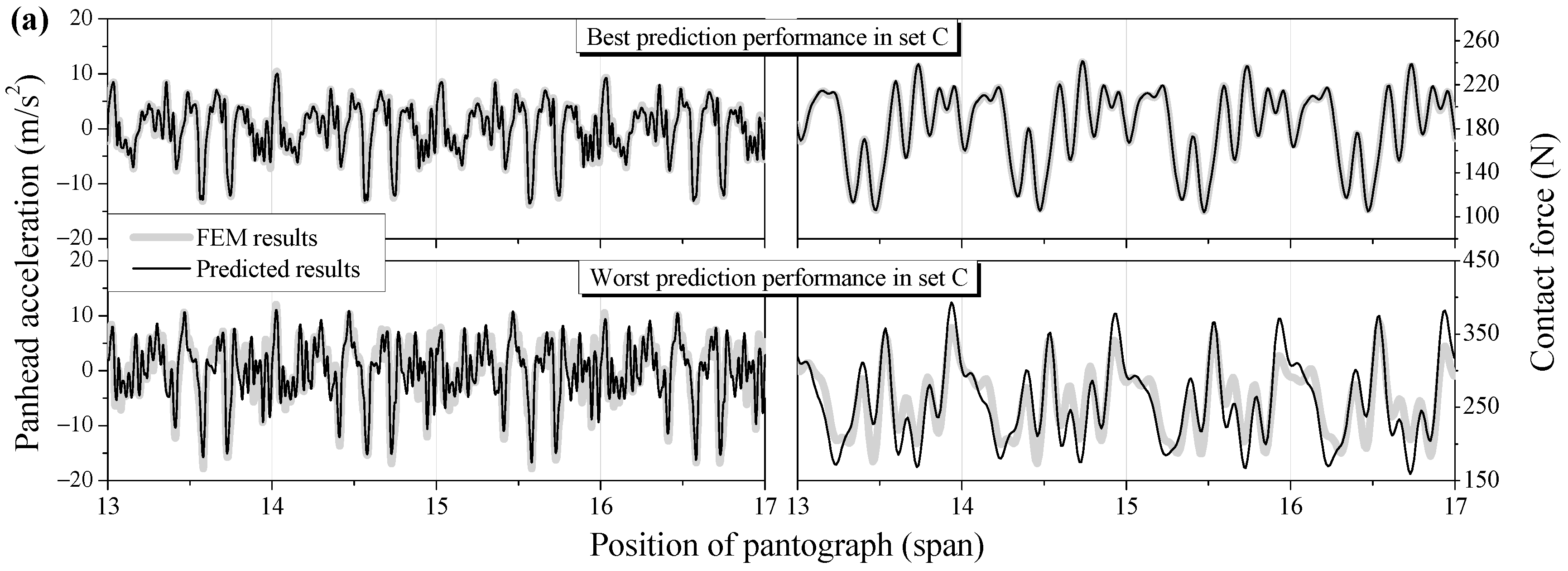
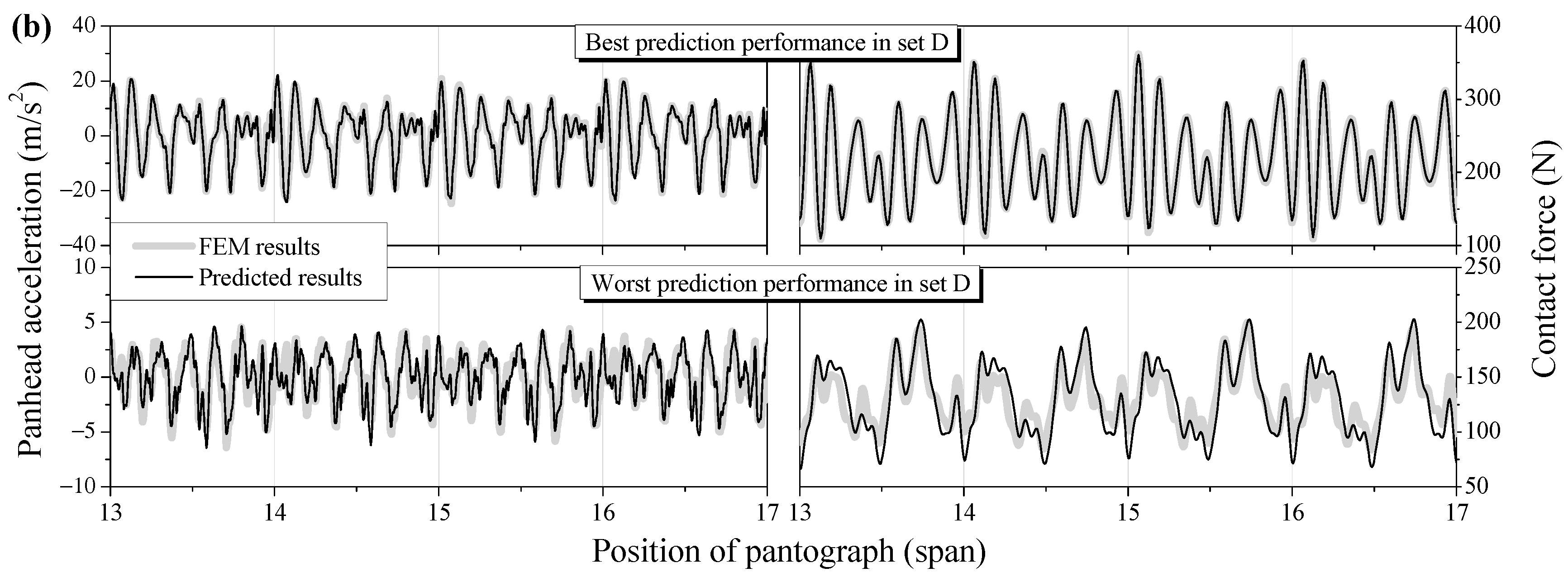

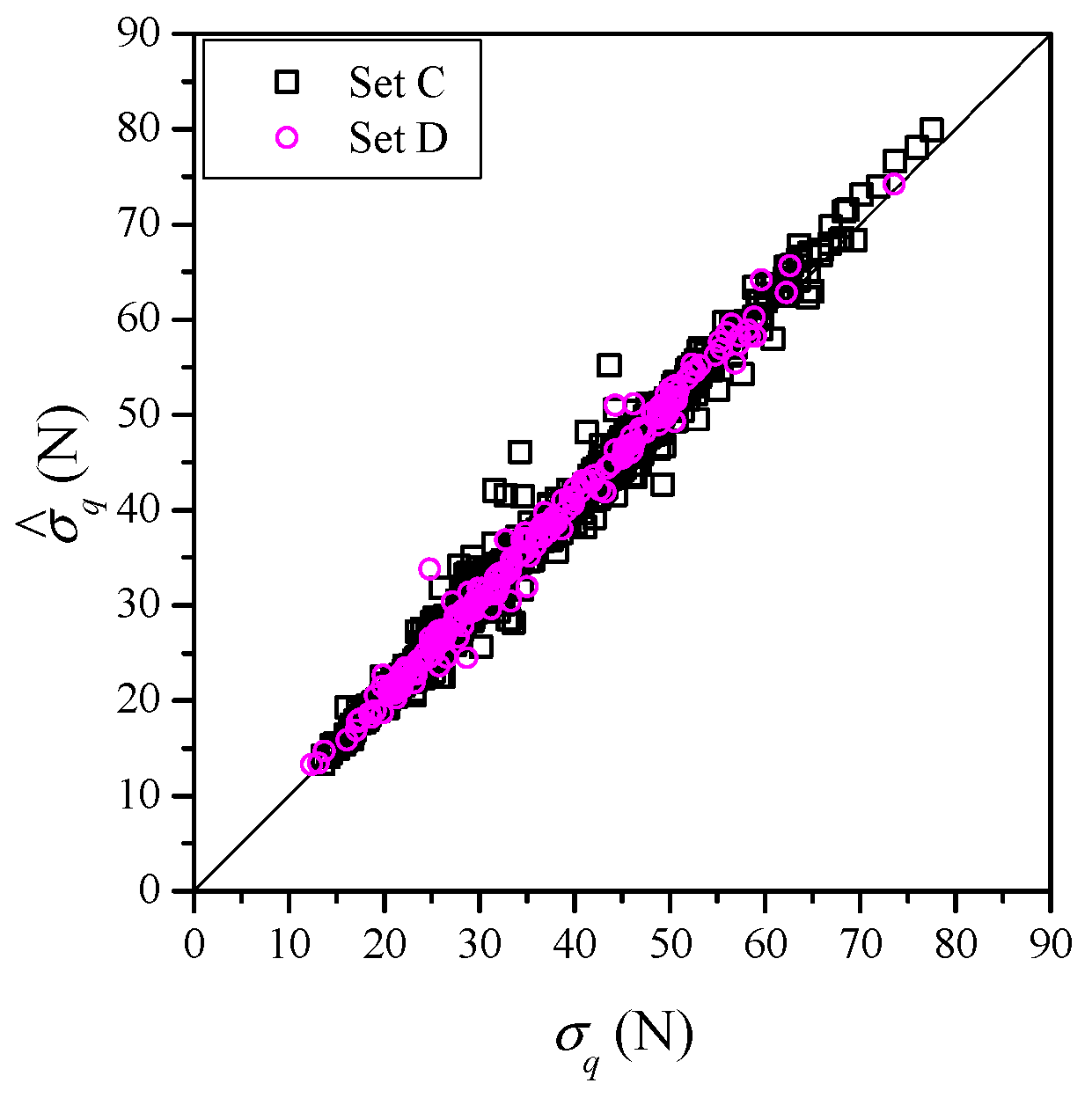
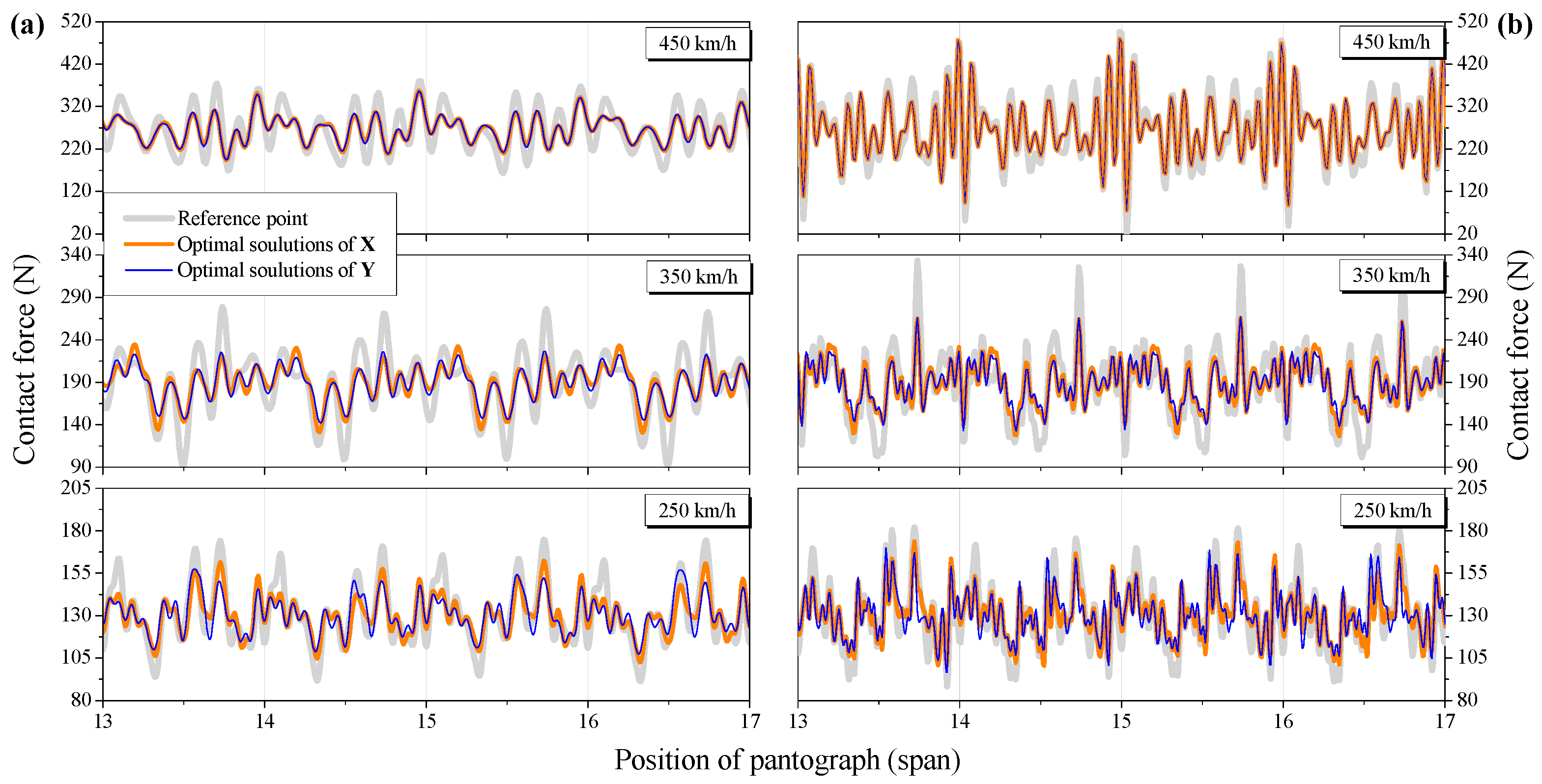

| Test Set | Determination Coefficient (%) | Model Error (N) | ||||
|---|---|---|---|---|---|---|
| σ | Interval within Probability of 0.95 | |||||
| Mean Value | Interval within Probability of 0.95 | Mean Value | Interval within Probability of 0.95 | |||
| C | 97.7 | (92.8, 100> | 97.4 | (91.0, 100> | 98.2 | <−2.35, 3.60> |
| D | 97.1 | (92.5, 100> | 97.3 | (91.5, 100> | 98.2 | <2.01, 4.11> |
Disclaimer/Publisher’s Note: The statements, opinions and data contained in all publications are solely those of the individual author(s) and contributor(s) and not of MDPI and/or the editor(s). MDPI and/or the editor(s) disclaim responsibility for any injury to people or property resulting from any ideas, methods, instructions or products referred to in the content. |
© 2024 by the authors. Licensee MDPI, Basel, Switzerland. This article is an open access article distributed under the terms and conditions of the Creative Commons Attribution (CC BY) license (https://creativecommons.org/licenses/by/4.0/).
Share and Cite
Wu, M.; Xu, X.; Zhang, H.; Zhou, R.; Wang, J. Pantograph–Catenary Interaction Prediction Model Based on SCSA-RBF Network. Appl. Sci. 2024, 14, 449. https://doi.org/10.3390/app14010449
Wu M, Xu X, Zhang H, Zhou R, Wang J. Pantograph–Catenary Interaction Prediction Model Based on SCSA-RBF Network. Applied Sciences. 2024; 14(1):449. https://doi.org/10.3390/app14010449
Chicago/Turabian StyleWu, Mengzhen, Xianghong Xu, Haochen Zhang, Rui Zhou, and Jianshan Wang. 2024. "Pantograph–Catenary Interaction Prediction Model Based on SCSA-RBF Network" Applied Sciences 14, no. 1: 449. https://doi.org/10.3390/app14010449
APA StyleWu, M., Xu, X., Zhang, H., Zhou, R., & Wang, J. (2024). Pantograph–Catenary Interaction Prediction Model Based on SCSA-RBF Network. Applied Sciences, 14(1), 449. https://doi.org/10.3390/app14010449





